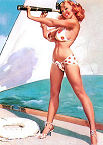TOMLABEL
Posts: 5116
Joined: 1/27/2006
From: Alabama - ROLL TIDE!!!!!
Status: offline

|
quote:
ORIGINAL: US87891
quote:
ORIGINAL: Rafid
Thanks for all the comments and data, Matt. You’re right when you say that week points play an important role in the life and death of a tank. Perhaps more so than shear frontal armor thickness.
Most of these "misc enemy weapon"s will have been gruesome to the wielder.
Any idea or explanation what the "misc non-enemy weapon" column is? Operational loses (hardly a "weapon"?!), friendly fire (seems too high)? For some of the early invasions in the pacific, these make up more than 60% of the losses.
I must admit my interest is sparked, but I'll be on vacation for a week. I’ll pick it up again when I’m back and try to go through the statistical data (from here and elsewhere). I would still argue that weighting has to be based on hit received, not fatal hits. There are for example no frontal “hollow charge” fatalities in the data provided, but that doesn’t mean that the front wasn’t hit, just that it couldn’t be penetrated by such weapons. Over optimizing the weighting perhaps is perhaps not sensible (but can be fun), since impact on final results will be small.
Have a nice time.
Data came from British, Canadian, French, US Army and USMC reports. Terms and conditions varied among the nationalities and the aggregate was compiled under yet different terms and conditions. It may have been more fair to call some of the ‘side’ things, simply “hull”.
Just looking at reports done in a uniform way, using uniform terminology, you get something like:
37% front, 60% side, 3% rear, 0% top, for gunfire
31% front, 51% side, 10% rear, 8% top, for hollow charge
Don’t believe it will change much if the entire data set was evaluated in this way. One can determine turret, upper, and lower sides from the data as well as turret vs hull front. I’m afraid upper and lower glacis is not differentiable. Japanese did not possess hollow charge so ignoring it does not distort the data. Sticky bombs, Molotov cocktails, rifle grenades, and the like, are weapons whose effects are included in the close assault phase of the algorithm. They do not apply during the various fire phases. Fun to know about all those things, but essentially irrelevant to the system mechanics.
Miscellaneous losses - At Tarawa, 42 tanks were unloaded (14 M4A2, 28 M3A1). Of these, 33 were lost (combat ineffective) and of these, 23 were from misc non-enemy causes; four when their LCMs were sunk, one lost (disabled) to US Navy dive bombers, eighteen lost to electrical failure from immersion or bogging after falling into shell craters (often also water filled). Saipan exhibited similar operational causes of loss; terrain and situational mechanical/electrical failure. Yes, friendly fire is included in that loss column, but incidence was low compared to just plain old something broke or driving over a cliff.
Matt
Interesting...
TOMLABEL
_____________________________
 Art by the Rogue-USMC WITP Admiral's Edition: Ship & Sub Art/Base Unit Art/Map Icon Art "If destruction be our lot - it will come from within"...Abraham Lincoln
|
 Printable Version
Printable Version







 New Messages
New Messages No New Messages
No New Messages Hot Topic w/ New Messages
Hot Topic w/ New Messages Hot Topic w/o New Messages
Hot Topic w/o New Messages Locked w/ New Messages
Locked w/ New Messages Locked w/o New Messages
Locked w/o New Messages Post New Thread
Post New Thread